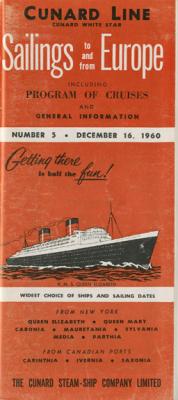The Sylvania’s career manifests the events and trends that shaped the world in the second half of the twentieth century. In the 1950s, many analysts, including those of the Cunard Line, believed that there were still enough passengers who desired to travel across the Atlantic in luxury and style to warrant the commissioning of several new ships. Though air travel was a growing industry, transatlantic flights were long and round-about, and most travelers still opted for traveling aboard an ocean liner. It seemed that the two modes of travel would continue to coexist. The Sylvania was the last of the four Saxonia-class ships that the Cunard Line commissioned and, beginning in 1957, she and her sister ships ferried passengers along the northern transatlantic route. In the event, she was one of the last ships commissioned by the Cunard Line and was among the last to travel the North Atlantic as a passenger liner.
Though the Sylvania’s first full year of service in 1958 was an immense success, it coincided with the introduction of the first direct transatlantic air service between Europe and North America. In that same year, the number of transatlantic passengers traveling by air first eclipsed those traveling by ocean liner. These new developments made the Sylvania increasingly obsolete for dedicated passenger travel. Although the Sylvania had been used intermittently for cruising since its launch in 1957, by 1965, when Judith crossed the North Atlantic, the Sylvania was routinely refitted each fall and scheduled for cruising in the Mediterranean during the winter months, when transatlantic traffic was low. In 1966, the Sylvania made her final Liverpool-New York sailing, and in 1967 her final Southampton-Canada and Liverpool-Halifax-New York sailings. With the rapid decline in the number of passengers traveling across the Atlantic by sea, Sylvania was sold by Cunard in 1968. She was subsequently sold and resold, named and renamed, until finally being scrapped at Alang, India, in 2004, after 57 years of active service.




